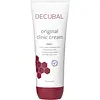What's inside
What's inside
 Key Ingredients
Key Ingredients

 Benefits
Benefits

 Concerns
Concerns

 Ingredients Side-by-side
Ingredients Side-by-side

Water
Skin ConditioningPentylene Glycol
Skin ConditioningCetearyl Isononanoate
EmollientGlycerin
HumectantSimmondsia Chinensis Seed Oil
EmollientGlyceryl Stearate
EmollientDicaprylyl Carbonate
EmollientPolyglyceryl-3 Methylglucose Distearate
EmulsifyingButyrospermum Parkii Butter
Skin ConditioningCetearyl Alcohol
EmollientGlyceryl Stearate Citrate
EmollientMagnesium Aluminum Silicate
AbsorbentPhytosphingosine
Skin ConditioningCholesterol
EmollientCeramide AP
Skin ConditioningCeramide NP
Skin ConditioningSorbitol
HumectantCaprylic/Capric Triglyceride
MaskingStearic Acid
CleansingPalmitic Acid
EmollientTocopherol
AntioxidantTocopheryl Acetate
AntioxidantGalactoarabinan
Xanthan Gum
EmulsifyingPolyglyceryl-2 Dipolyhydroxystearate
Skin ConditioningSodium Stearoyl Lactylate
EmulsifyingSodium Gluconate
Skin ConditioningCitric Acid
BufferingSodium Hydroxide
BufferingWater, Pentylene Glycol, Cetearyl Isononanoate, Glycerin, Simmondsia Chinensis Seed Oil, Glyceryl Stearate, Dicaprylyl Carbonate, Polyglyceryl-3 Methylglucose Distearate, Butyrospermum Parkii Butter, Cetearyl Alcohol, Glyceryl Stearate Citrate, Magnesium Aluminum Silicate, Phytosphingosine, Cholesterol, Ceramide AP, Ceramide NP, Sorbitol, Caprylic/Capric Triglyceride, Stearic Acid, Palmitic Acid, Tocopherol, Tocopheryl Acetate, Galactoarabinan, Xanthan Gum, Polyglyceryl-2 Dipolyhydroxystearate, Sodium Stearoyl Lactylate, Sodium Gluconate, Citric Acid, Sodium Hydroxide
Ingredients Explained
These ingredients are found in both products.
Ingredients higher up in an ingredient list are typically present in a larger amount.
Glycerin is already naturally found in your skin. It helps moisturize and protect your skin.
A study from 2016 found glycerin to be more effective as a humectant than AHAs and hyaluronic acid.
As a humectant, it helps the skin stay hydrated by pulling moisture to your skin. The low molecular weight of glycerin allows it to pull moisture into the deeper layers of your skin.
Hydrated skin improves your skin barrier; Your skin barrier helps protect against irritants and bacteria.
Glycerin has also been found to have antimicrobial and antiviral properties. Due to these properties, glycerin is often used in wound and burn treatments.
In cosmetics, glycerin is usually derived from plants such as soybean or palm. However, it can also be sourced from animals, such as tallow or animal fat.
This ingredient is organic, colorless, odorless, and non-toxic.
Glycerin is the name for this ingredient in American English. British English uses Glycerol/Glycerine.
Learn more about GlycerinWater. It's the most common cosmetic ingredient of all. You'll usually see it at the top of ingredient lists, meaning that it makes up the largest part of the product.
So why is it so popular? Water most often acts as a solvent - this means that it helps dissolve other ingredients into the formulation.
You'll also recognize water as that liquid we all need to stay alive. If you see this, drink a glass of water. Stay hydrated!
Learn more about Water